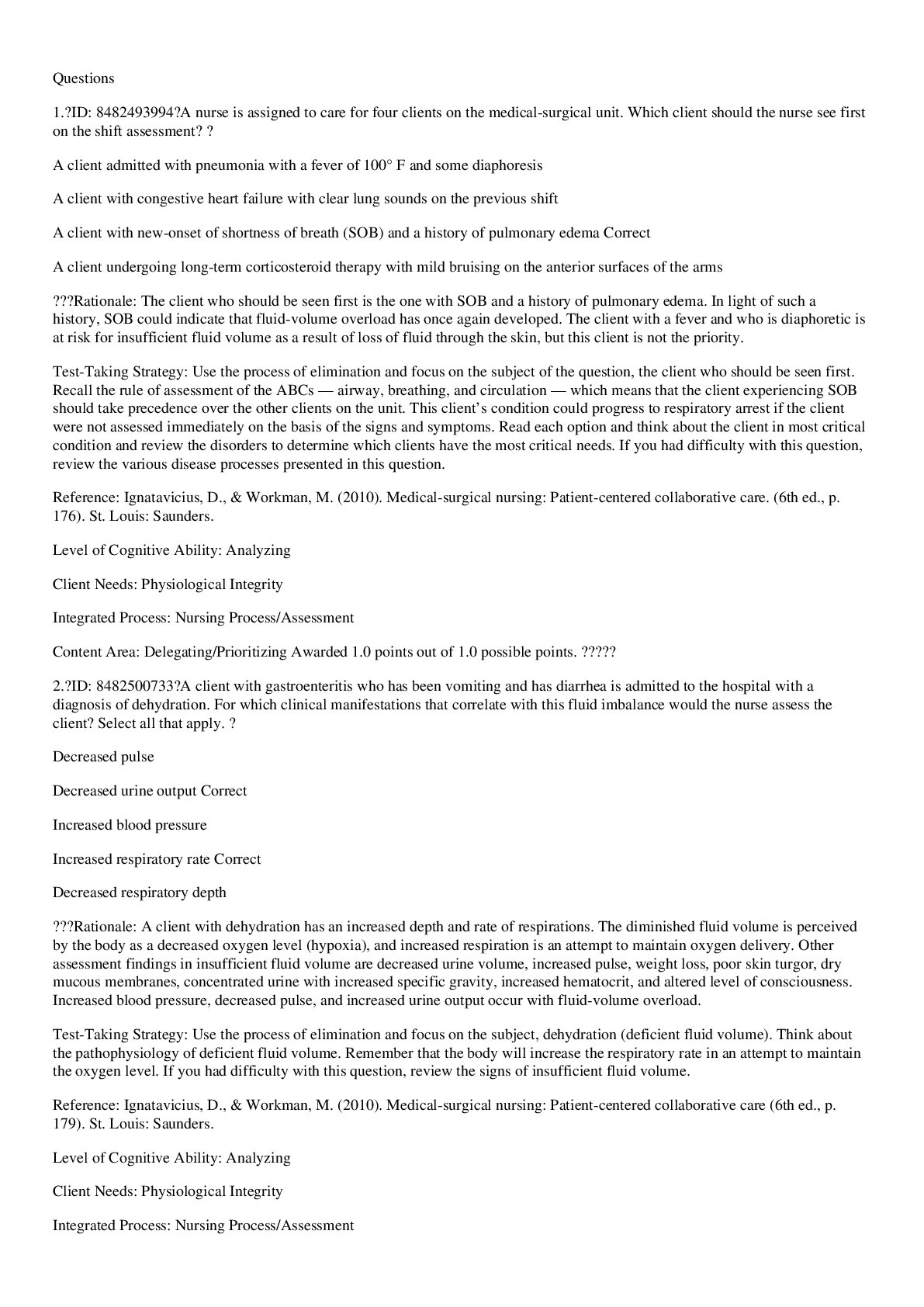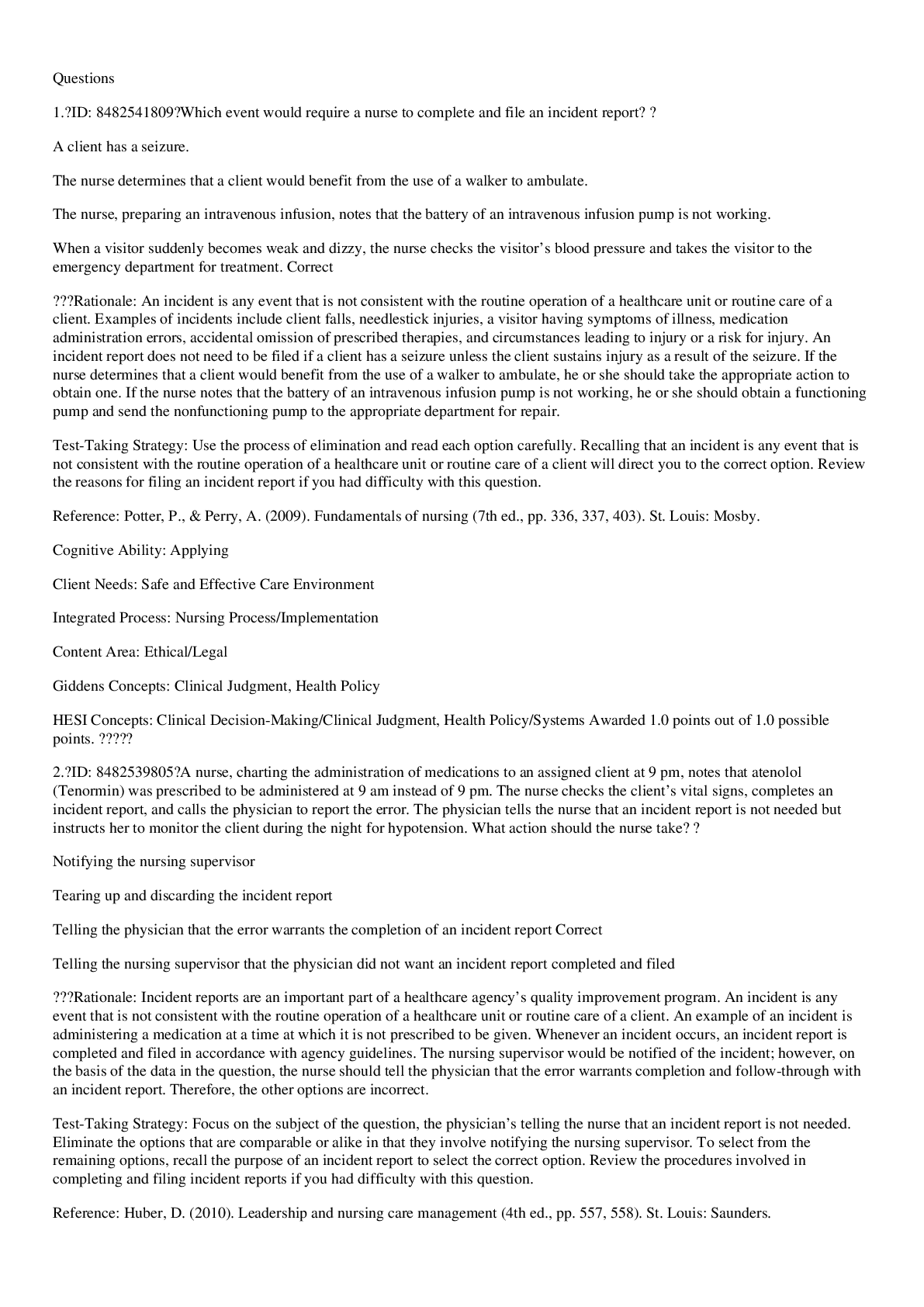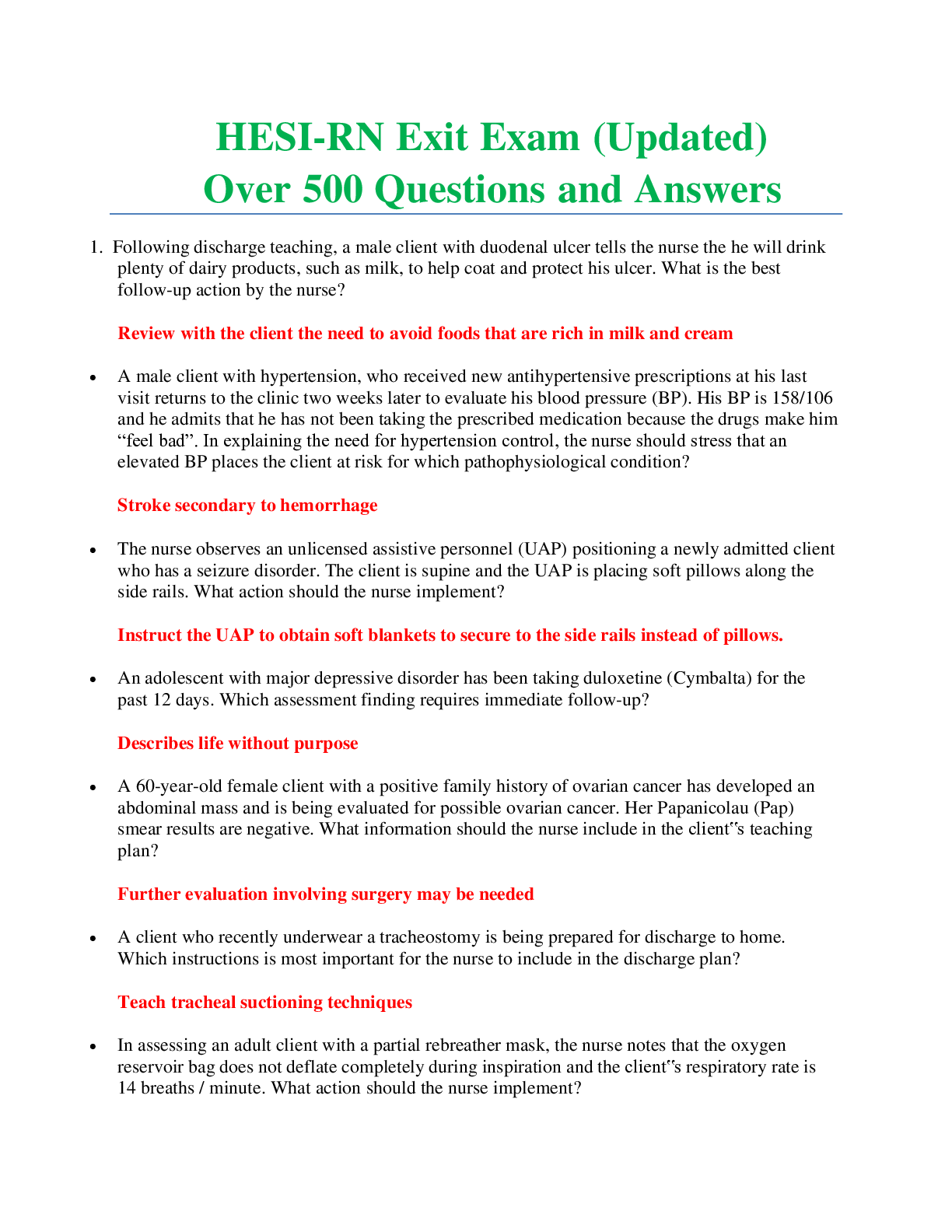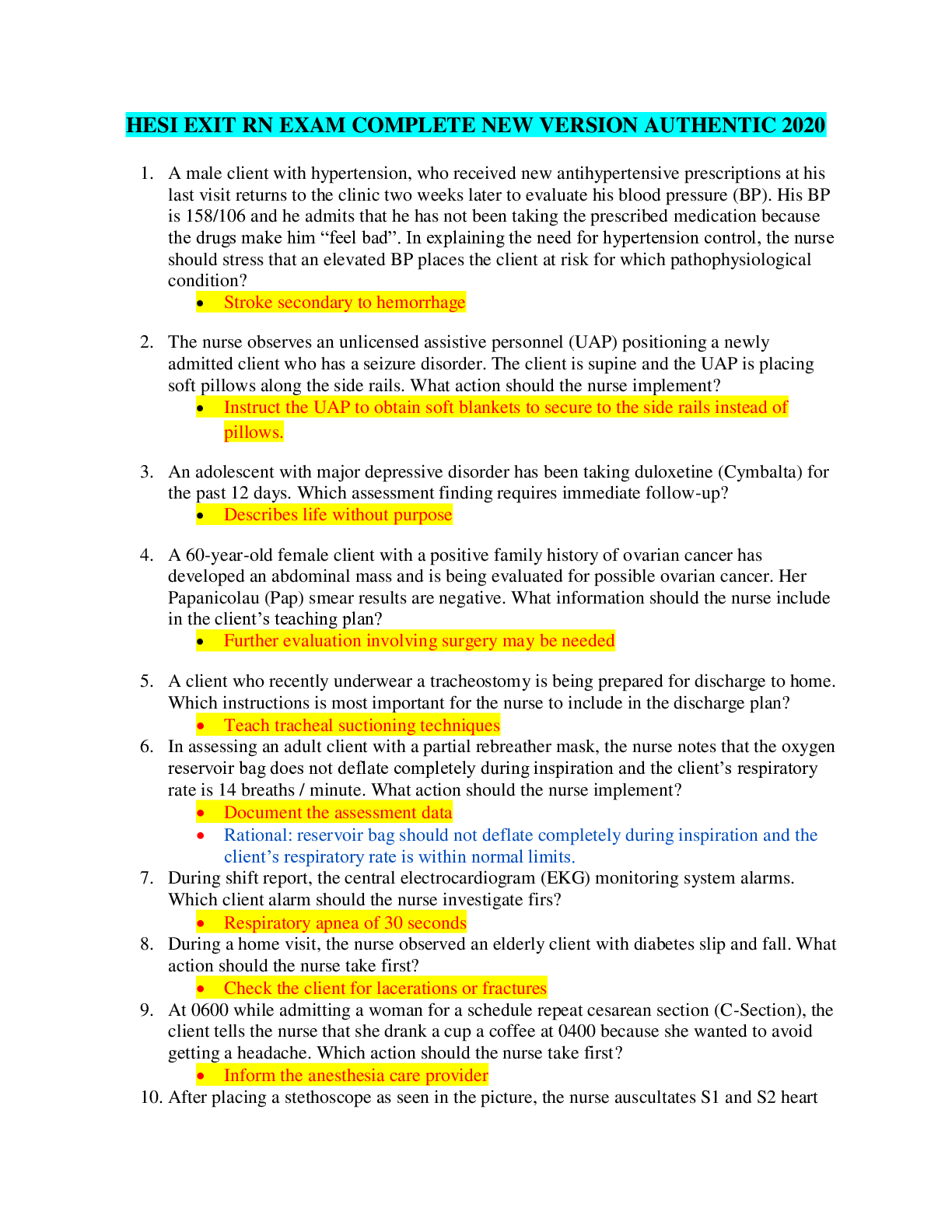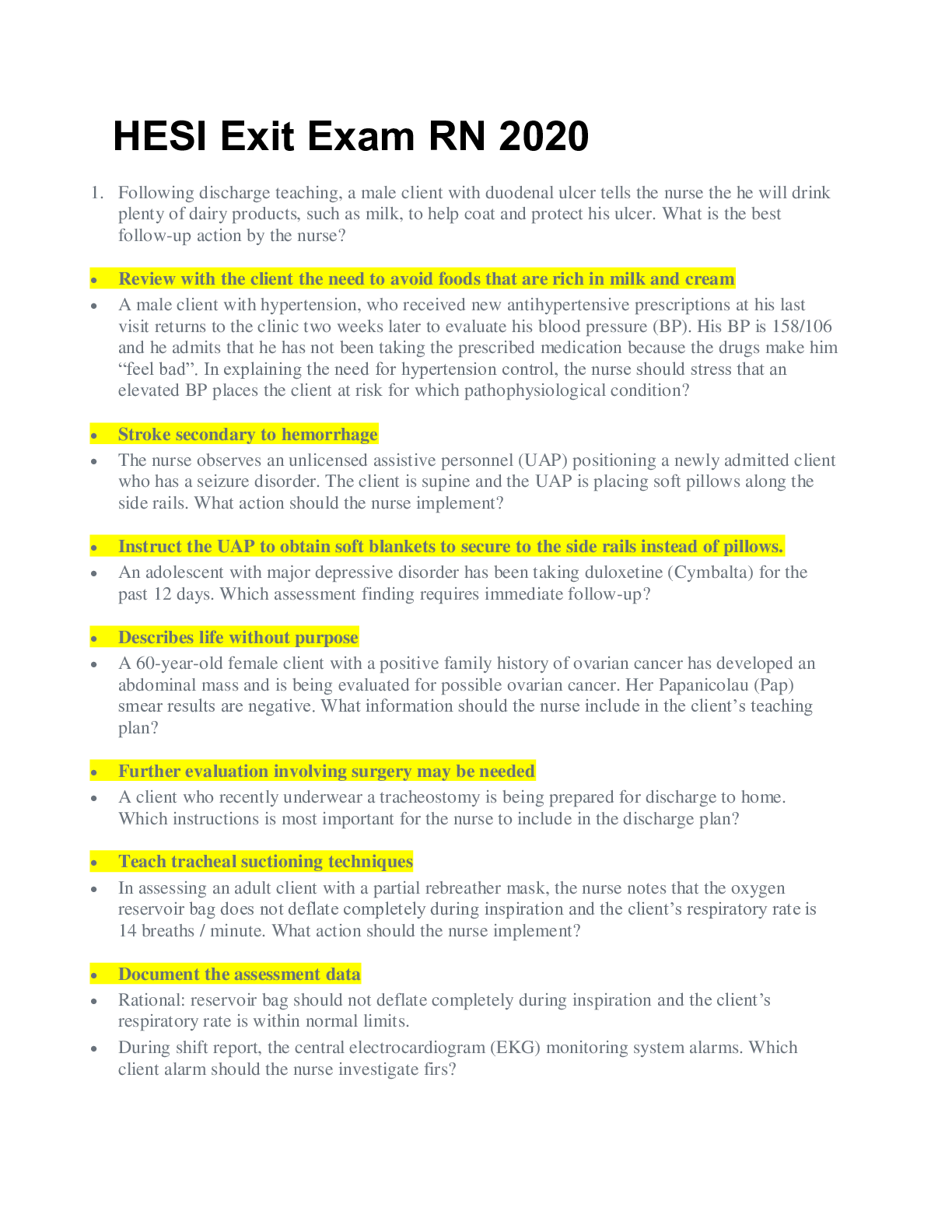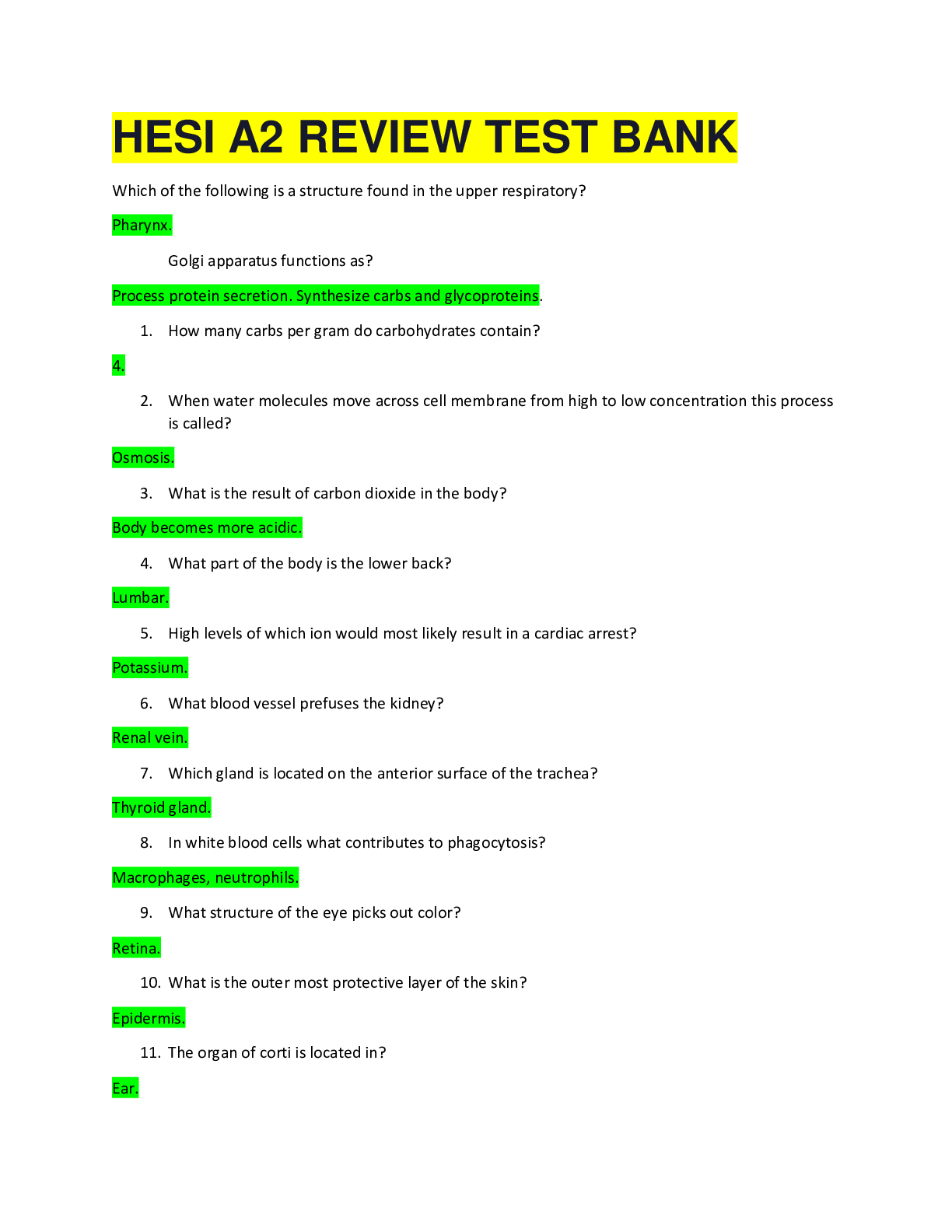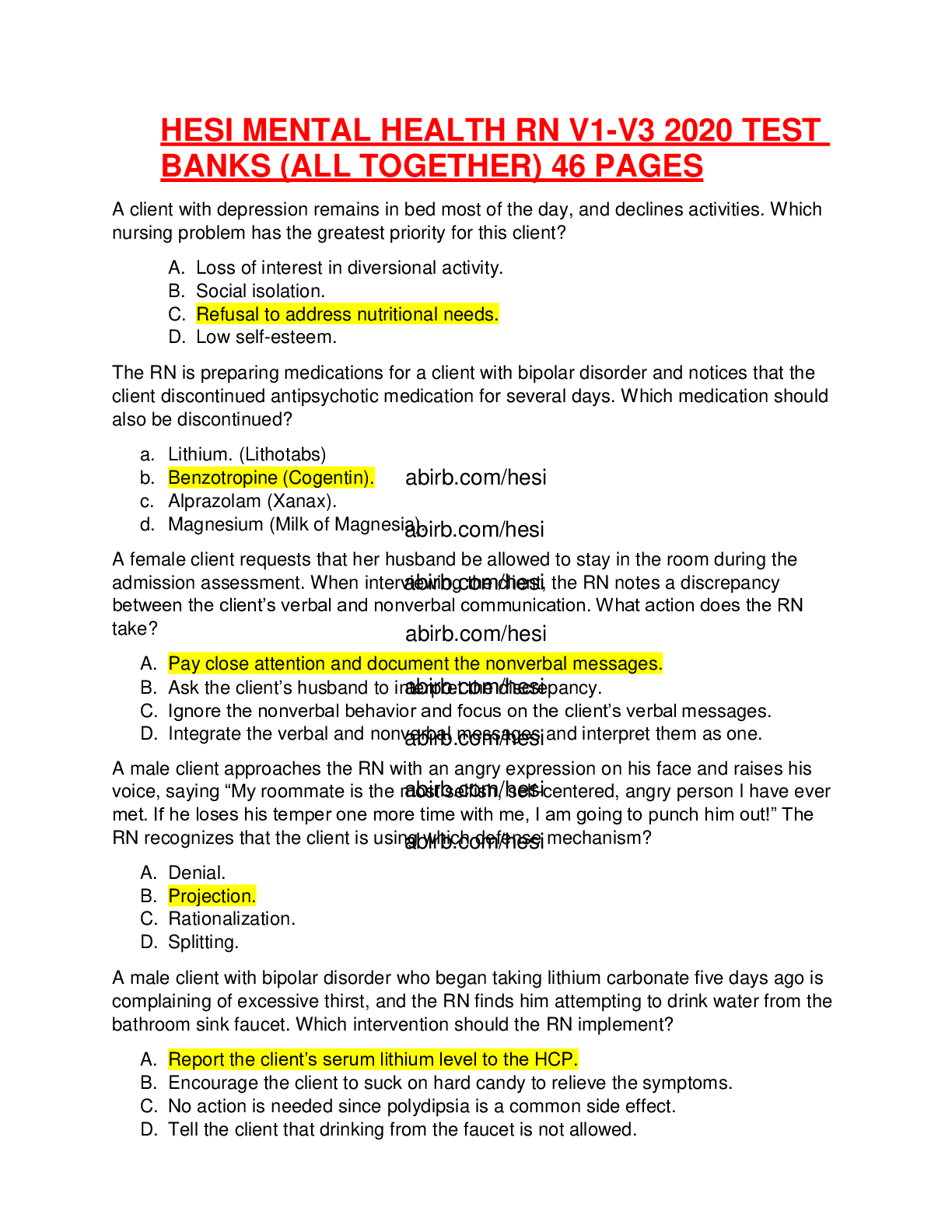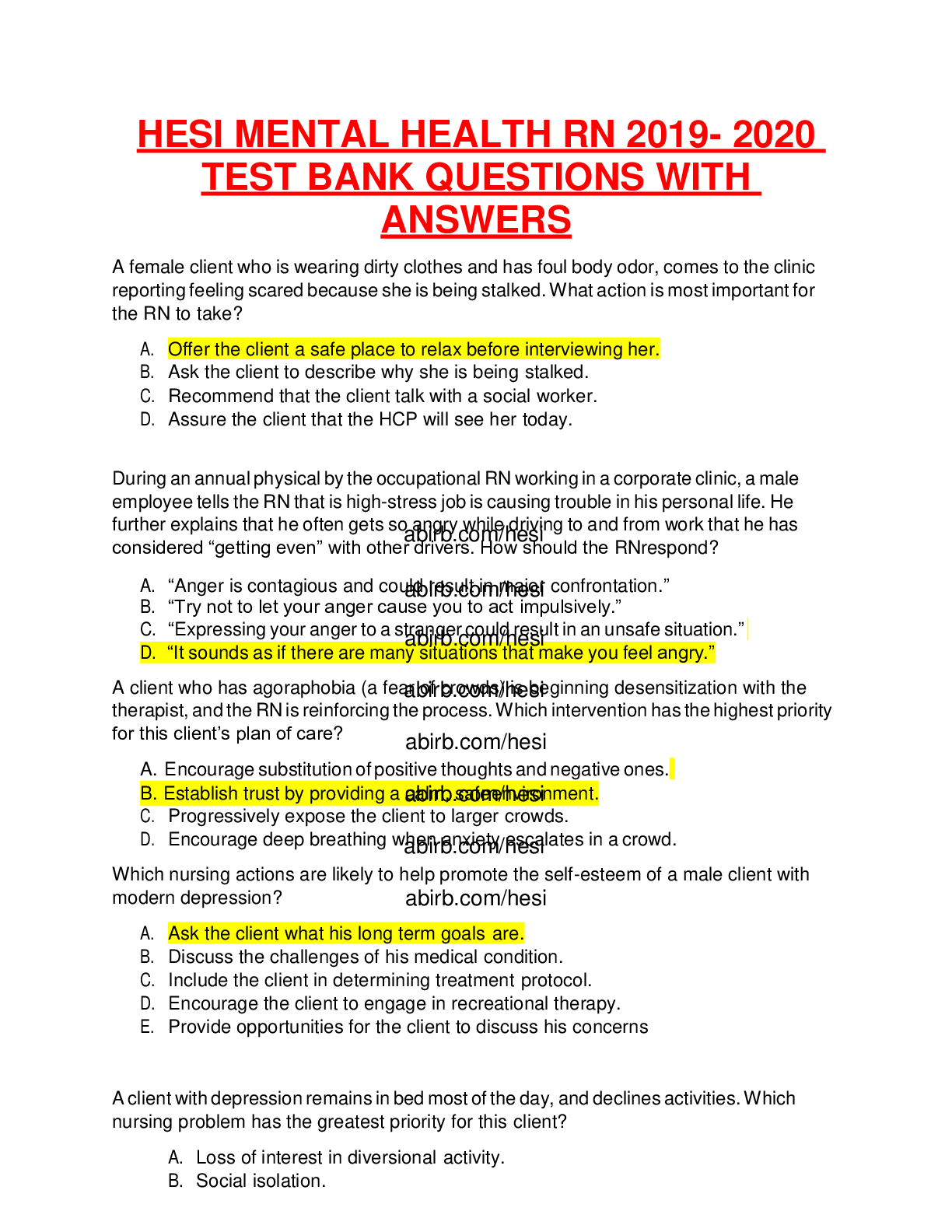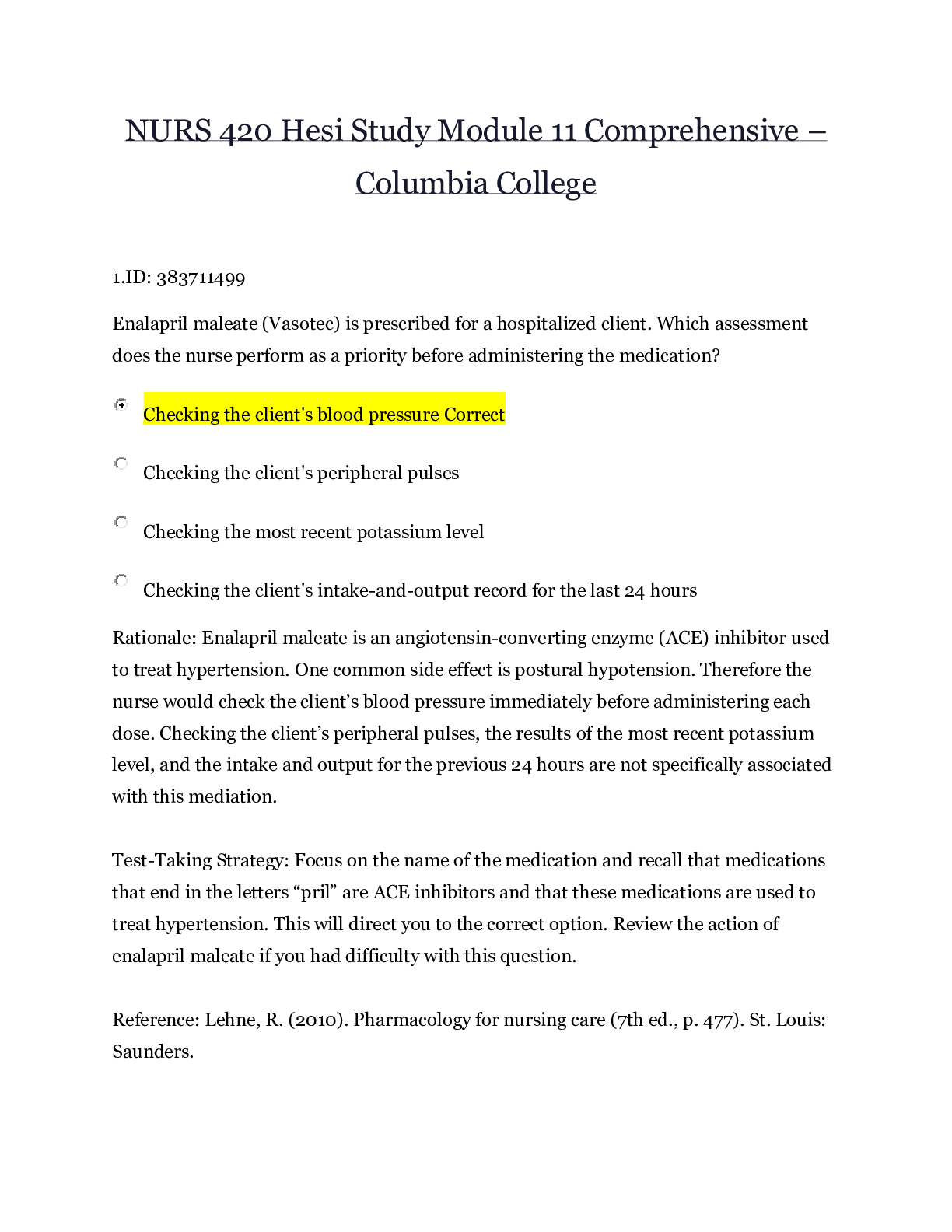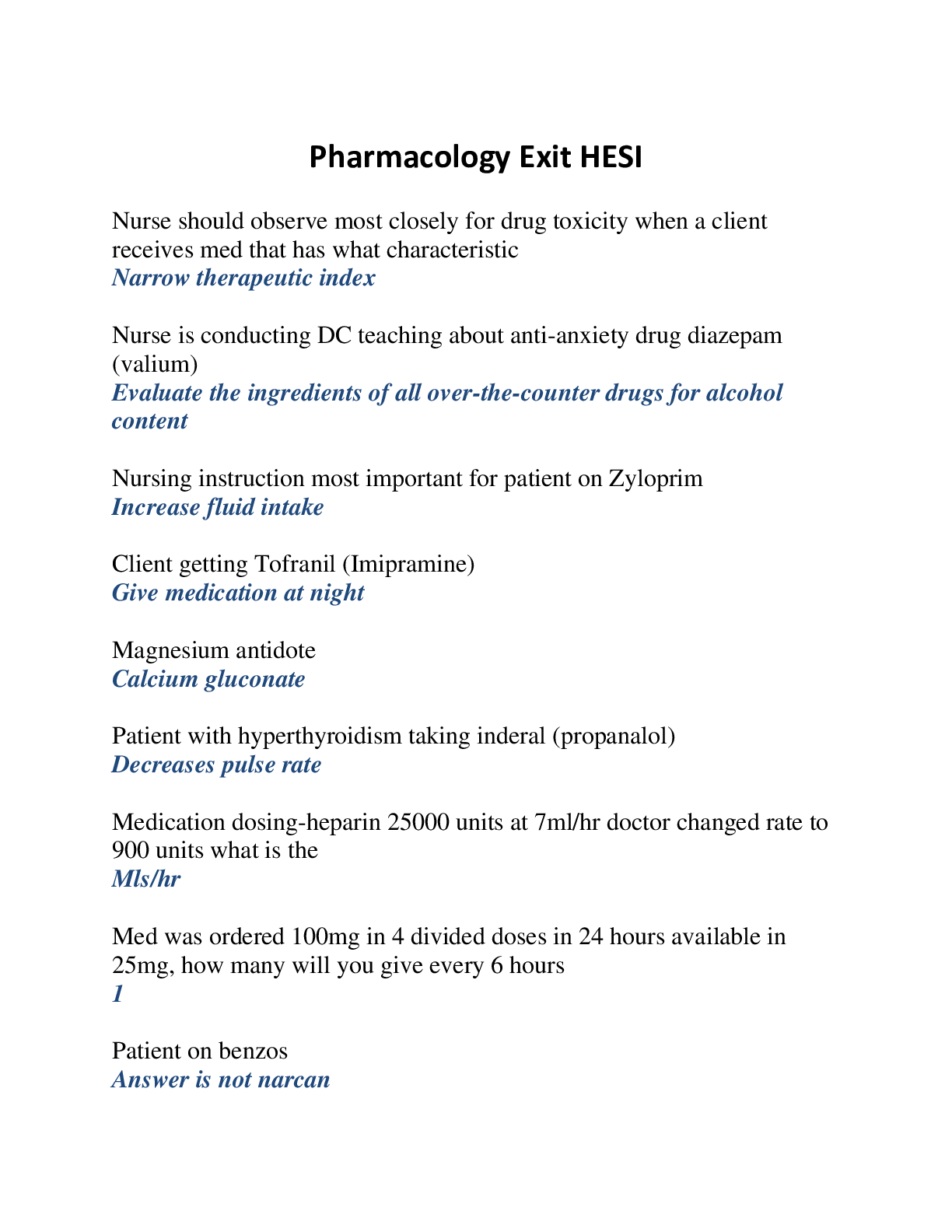Detailed HESI Study Guide
Document Content and Description Below
ADVANCED CLINICAL CONCEPTS • ARDS is an unexpected, catastrophic pulmonary complication occurring in a person with no previous pulmonary problems. The mortality rate is high (50%) • In ARDS, a... common laboratory finding is lowered PO2. However, these clients are not very responsive to high concentrations of oxygen. • Think about the physiology of the lungs by remembering PEEP: Positive End Expiratory Pressure is the instillation and maintenance of small amounts of air into the alveolar sacs to prevent them from collapsing each time the client exhales. The amount of pressure can be set with the ventilator and is usually around 5 to 10 cm of water. • Suction only when secretions are present. • Before drawing arterial blood gases from the radial artery, perform the Allen test to assess collateral circulation. Make the client’s hand blanch by obliterating both the radial and ulnar pulses. Then release the pressure over the ulnar artery only. If flow through the ulnar artery is good, flushing will be seen immediately. The Allen test is then positive, and the radial artery can be used for puncture. If the Allen test is negative, repeat on the other arm. If this test is also negative, seek another site for arterial puncture. The Allen test ensures collateral circulation to the hand if thrombosis of the radial artery should follow the puncture. • If the client does not have O2 to his/her brain, the rest of the injuries do not matter because death will occur. However, they must be removed from any source of imminent danger, such as a fire. • PC)2 >45 or PO2 <60 on 50% O2 signifies respiratory failure. • A child in severe distress should be on 100% O2. • Early signs of shock are agitation and restlessness resulting from cerebral hypoxia. • If cardiogenic shock exists with the presence of pulmonary edema, i.e., from pump failure, position client to REDUCE venous return (HIGH FOWLER’s with legs down) in order to decrease venous return further to the left ventricle. • Severe shock leads to widespread cellular injury and impairs the integrity of the capillary membranes. Fluid and osmotic proteins seep into the extra vascular spaces, further reducing cardiac output. A vicious cycle of decreased perfusion to ALL cellular level activities ensues. All organs are damaged, and if perfusion problems exist, the damage can be permanent. • All vasopressors/vasodilator drugs are potent and dangerous and require weaning on and off. Do not change infusion rates simultaneously. • A client is brought into the hospital suffering shock symptoms as a result of a bee sting. What is the first priority? Maintaining an open airway (the allergic reaction damages the lining of the airways causing edema). Also, keep the client warm without constricting clothing; keep legs elevated (not Trendelenburg because the weight of the lower organs restricts breathing). • Epinephrine: 1:1000, 0.2 to 0.5ml subq for mild • Epinephrine: 1:10,000, or 5ml IV for severe • Volume expanding fluids are usually given to clients in shock. However, if the shock is cardiogenic, pulmonary edema may result. • Drugs of choice for shock - Digitalis preparations: Increase the contractility of the heart muscle - Vasoconstrictors (Levophed, Dopamine): Generalized vasonconstriction to provide more available blood to the heart to help maintain cardiac output. • A common volume-expanding substance is plasma and possibly whole blood. • You are caring for a woman who was in severe automobile accident several days ago. She has several fractures and internal injuries. The exploratory laparotomy was successful in controlling the bleeding. However, today you find that this client is bleeding from her incision, short of breath, has a weak thready pulse, has cold and clammy skin, and hematuria. - What do you think is wrong with the client, and what would you expect to do about it? - These are typical signs and symptoms of DIC crisis. Expect to administer IV heparin to block the formation of thrombin (Coumadin does not do this). However, the client described is already past the coagulation phase and into the hemorrhagic phase. Her management would be administration of clotting factors along with palliative treatment of the symptoms as they arise. (Her prognosis is poor). • NCLEX-RN questions on CPR often deal with prioritization of actions. Question: What actions are required for each of the following situations? - A 24-year old motorcycle accident vistim with a ruptured artery if the leg is pulseless and apneic. - A 36-year old first time pregnant woman who arrests during labor. - A 17-year old with no pulse or respirations who is trapped in an overturned car, which is starting to catch fire. - A 40-year old businessman who arrests two days after a cervical laminectomy. • WHEN TO SEEK EMERGENCY MEDICAL SERVICE (EMS) - The American Heart Association recommends that those with known angina pectoris seek emergency medical care if chest pain is NOT relieved by three nitroglycerin tablets 5 minutes apart over a 150minute period. - A person with previously unrecognized coronary disease experiencing chest pain persisting for 2 minutes or longer should seek emergency medical treatment. • It is important for the nurse to stay current with the American Heart Association’s guidelines for Basic Life Support (BLS) by being certified every two years as required. 1• If one rescuer is performing CPR, 1 15:2 ratio of compression to ventilations is performed for 4 cycles, then reassess for breathing and pulse. If two rescuers are performing CPR, a 15:2 ratio is now recommended for compressions to ventilations. Perform for 15 cycles with a 100/min compression rate. When trading off, start with compressions. • Initiate CPR with BLS guidelines immediately, then move on to Advanced Cardiac Life Support (ACLS) guidelines. • When significant arterial acidosis is noted, try to reduce PCO2 by increasing ventilation, which will correct arterial, venous, and tissue acidosis. Bicarbonate may exacerbate acidosis b producing CO2. Thus, the ACLS guidelines have recommended bicarbonate NOT be used unless hyperkalemia and/or preexisting acidosis is documented. • Infants/prematures may have problems with the following that can predispose to arrest: Beware of the “H’s” – hypoxia, hypoglycemia, hypothermia, increased H+ (metabolic and/or respiratory acidosis), hypercoagulability (if polycythemia exists). • Changes is osmolarity cause shifts in fluid. The osmolarity of the extracellular fluid (ECF) is almost entriely due to sodium. The osmolarity of intracellular fluid (ICF) is related to many particles, with potassium being the primary electrolyte. The pressures in the ECF and the ICF are almost identical. If either ECF or ICF change in concentration, fluid shifts from the area of lesser concentration to the area of greater concentration. • Dextrose 10% is a hypertonic solution and should be administered IV. • Normal saline is an isotonic solution and is used for irrigations, such as bladder irrigations or IV flush lines with intermittent IV medication. • Use only isotonic (neutral) solutions in irrigations, infusions, etc., unless the specific aim is to shift fluid into intracellular or extracellular spaces. • Potassium imbalances are potentially life-threatening, must be corrected immediately. A low magnesium often accompanies a low K+, especially with the use of diuretics. • Fluid Volume Deficit: Dehydration - Elevated BUN: The BUN measures the amount of urea nitrogen in the blood. Urea is formed in the liver as the end product of protein metabolism. The BUN is directly related to the metabolic function of the liver and the excretory function of the kidneys. - Creatinine, as with BUN, is excreted entirely by the kidneys and is therefore directly proportional to renal excretory function. However, unlike BUN, the creatinine level is affected very little by dehydration, malnutrition, or hepatic function. The daily production of creatinine depends on muscle mass, which fluctuates very little. Therefore, it is a better test of renal function than is the BUN. Creatinine is generally used in conjunction with the BUN test and they normally are in a 1:20 ratio. - Serum osmolality measures the concentration of particles in a solution. It refers to the fact that the same amount of solute is present, but the amount of solvent (fluid) is decreased. Therefore, the blood can be considered “more concentrated.” - Urine osmolality and specific gravity increase. • Check the IV tubing container to determine the drip factor because drip factors vary. The most common drip factors are 10, 12, 15, and 60 drops per milliliter. A microdrip is 60 drops per milliliter [Show More]
Last updated: 1 year ago
Preview 1 out of 27 pages

Buy this document to get the full access instantly
Instant Download Access after purchase
Add to cartInstant download
We Accept:

Reviews( 0 )
$14.00
Document information
Connected school, study & course
About the document
Uploaded On
Oct 18, 2020
Number of pages
27
Written in
Additional information
This document has been written for:
Uploaded
Oct 18, 2020
Downloads
0
Views
56

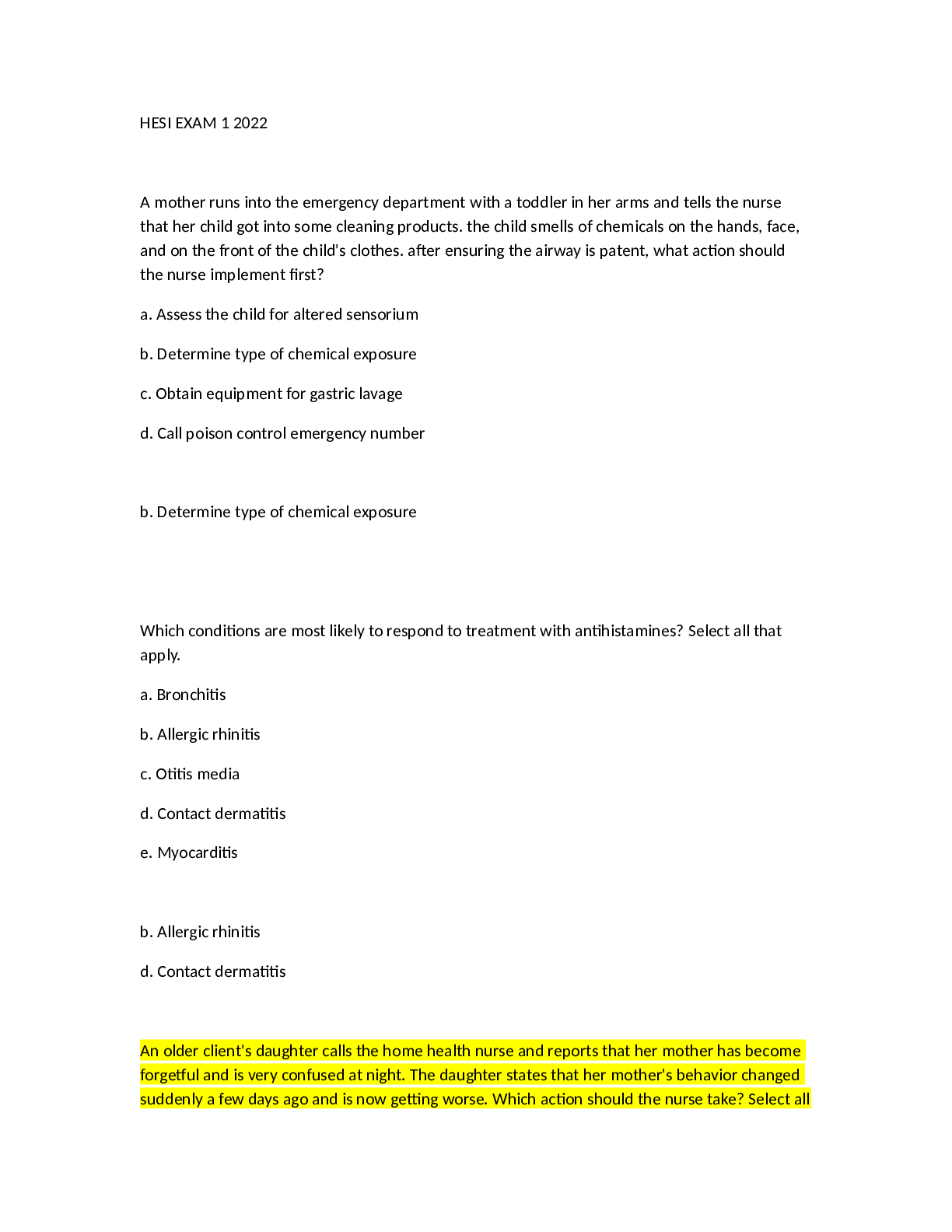
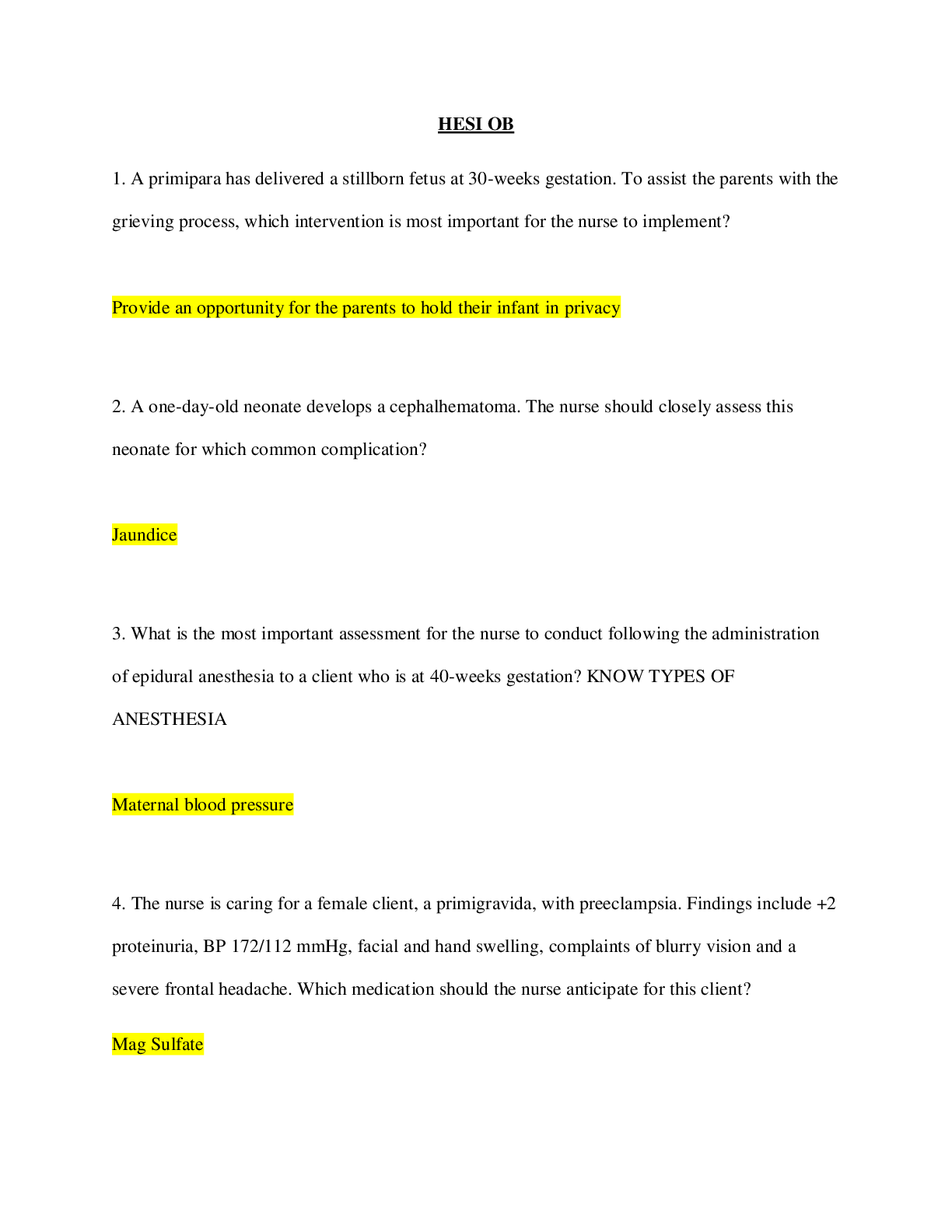
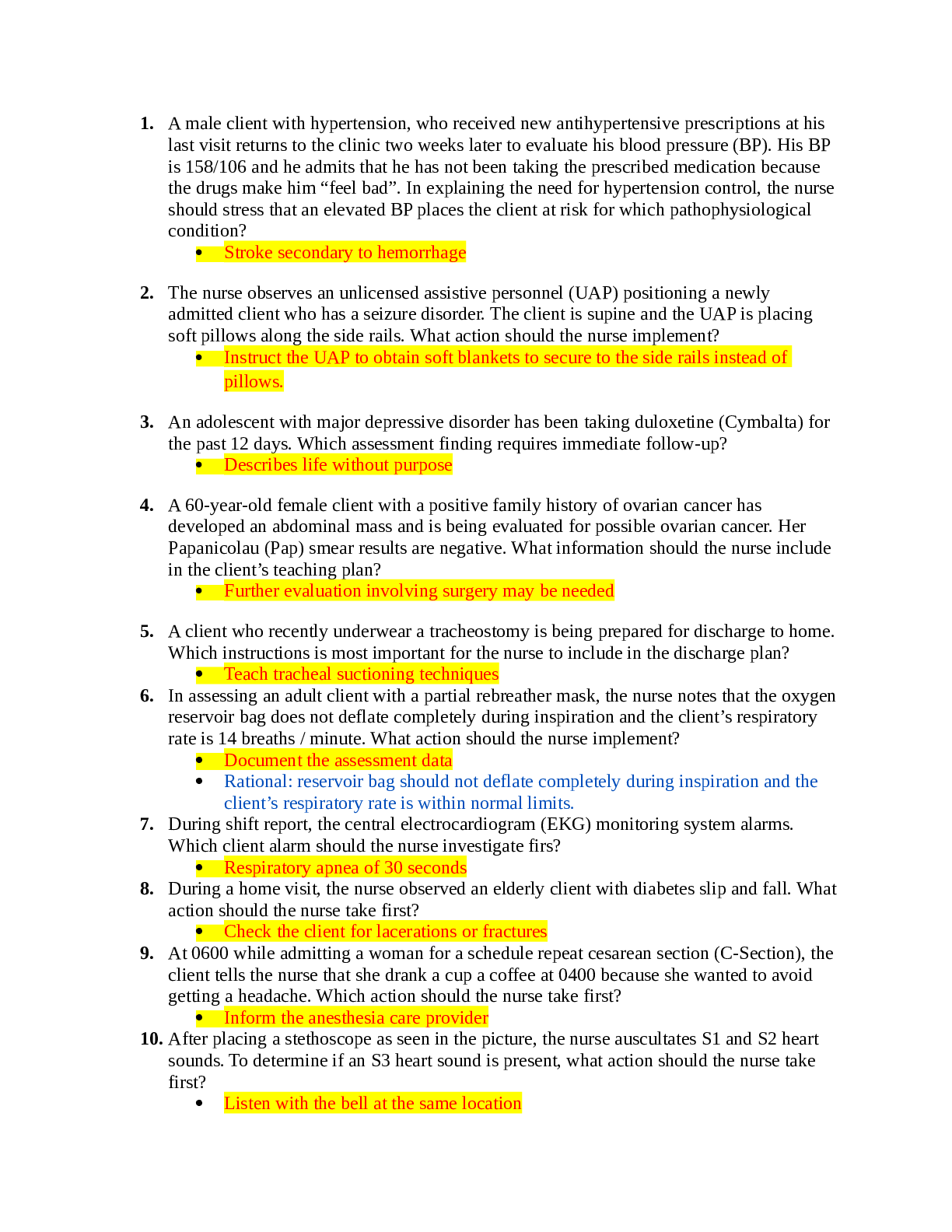


.png)
